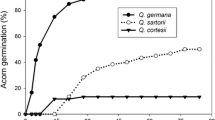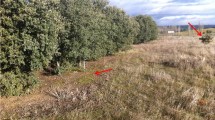Abstract
Acorns of many white oak species germinate soon after autumn seed fall, a characteristic widely interpreted as a general adaptation to escape predation by small rodents. However, the mechanism by which early, rapid germination allows escape and/or tolerance of seed damage remains unclear. Here we reported how specific germination traits of chestnut oak (Quercus montana) acorns, and those of other white oak species, allow successful escape from acorn pruning by rodents. During germination, chestnut oak acorns develop elongated cotyledonary petioles, which extend beyond the distal end of the acorn (1–2 cm) to the point at which the epicotyl and radicle diverge. However, granivorous rodents often prune the taproots above or below the plumule when eating or caching these germinated acorns in autumn. Hence, we hypothesized elongation of cotyledonary petioles allows chestnut oaks to escape acorn pruning by rodents. We simulated pruning by rodents by cutting the taproot at different stages of germination (radicle length) to evaluate the regeneration capacity of four resulting seedling remnants following taproot pruning: acorns with the plumule (remnant I), acorns without the plumule (remnant II), and pruned taproots with (remnant III) or without the plumule (remnant IV). Our results showed that remnant I germinated into seedlings regardless of the length of the taproot previously pruned and removed. Remnant III successfully germinated and survived provided that taproots were ≥6 cm in length, whereas remnant IV was unable to produce seedlings. Remnant II only developed adventitious roots near the severed ends of the cotyledonary petioles. Field experiments also showed that pruned taproots with the plumule successfully regenerated into seedlings. We suggest that the elongated cotyledonary petioles, typical of most white oak species in North America, represent a key adaptation that allows frequent escape from rodent damage and predation. The ability of pruned taproots to produce seedlings suggests a far greater resilience of white oaks to seed predation than previously anticipated.







Similar content being viewed by others
References
Bossema L (1968) Recovery of acorns in the European Jay (Garrulus glandarius L.). Proc K Ned Akad Wet C 71:1–5
Bossema L (1979) Jays and oaks: An eco-ethological study of a symbiosis. Behaviour 70:1–117
Cao L, Xiao Z, Wang ZY, Guo C, Chen J, Zhang ZB (2011) High regeneration capacity helps tropical seeds to counter rodent predation. Oecologia 166:997–1007
Chang G, Xiao ZS, Zhang ZB (2009) Hoarding decisions by Edward’s long-tailed rats (Leopoldamys edwardsi) and South China field mice (Apodemus draco): the responses to seed size and germination schedule in acorns. Behav Proc 82:7–11
Crawley MJ (2000) Seed predators and plant population dynamics. In: Fenner D (ed) Seeds: the ecology of regeneration in plant communities. CAB International Publishing, Wallingford,UK, pp 167–182
Elliott L (1978) Social behavior and foraging ecology of eastern chipmunk (Tamias striatus) in the Adirondack Mountains. Smithson Contrib Zool 265:1–107
Fox JF (1974) Coevolution of white oak and its seed predators. Ph.D. dissertation. University of Chicago, Chicago, p 90
Fox JF (1982) Adaptation of gray squirrel behaviour to autumn germination by white oak acorns. Evolution 36:800–809
Gendron RP, Reichman OJ (1995) Food perishability and inventory management: a comparison of three caching strategies. Am Nat 145:948–968
Hadj-Chikh LZ, Steele MA, Smallwood PD (1996) Caching decisions by grey squirrels: a test of the handling time and perishability hypotheses. Anim Behav 52:941–948
Hulme PE, Benkman CW (2002) Granivory. In: Herrera CM, Pellmyr O (eds) Plant–animal interactions. Blackwell Science, pp 132–154
Jansen PA, Bongers FH, Prins HT (2006) Tropical rodents change rapidly germinating seeds into long-term food supplies. Oikos 113:449–458
Kitajima K, Fenner M (2000) Ecology of seedling regeneration. In: Fenner D (ed) Seeds: the ecology of regeneration in plant communities. CAB International Publishing, Walingford,UK, pp 331–359
Lewis IM (1911) The seedling of Quercus virginiana. Plant World 14:119–123
McEuen AB, Steele MA (2005) Atypical acorns appear to allow escape after apical notching by tree squirrels. Am Midl Nat 154:450–458
Moore J, McEuen AB, Swihart RK, Contreras TA, Steele MA (2007) Determinants of seed removal distance by scatter-hoarding rodents in deciduous forests. Ecology 88:2529–2540
Perea R, San Miguel A, Gil L (2011) Leftovers in seed dispersal: ecological implications of partial seed consumption for oak regeneration. J Ecol 99:194–201
Reichman OJ (1988) Caching behavior by eastern woodrats, Neotoma floridana, in relation to food perishability. Anim Behav 36:1525–1532
Sands BA, Abrams MD (2009) Effects of stump diameter on sprout number and size for three oak species in a Pennsylvania clearcut. North J Appl For 26:122–125
Steele MA (2008) Evolutionary interactions between tree squirrels and trees: a review and synthesis. Curr Sci 95:871–876
Steele MA, Smallwood PD (2001) Acorn dispersal by birds and mammals. In: McShea WJ, Healey W (eds) Oak forest ecosystems: ecology and management for wildlife. Johns Hopkins University Press, Baltimore, pp 182–195
Steele MA, Carlson JE, Smallwood PD, McEuen AB, Contreras TA, Terzaghi WB (2007) Linking seed and seed shadows: a case study in the oaks (Quercus). In: Dennis AJ, Schupp EW, Green RJ, Wescott DA (eds) Seed dispersal: theory and its application in a changing world. CAB International, Wallingford, UK, pp 322–339
Steele MA, Knowles T, Bridle K, Simms EL (1993) Tannins and partial consumption of acorns: implications for dispersal of oaks by seed predators. Am Midl Nat 130:229–238
Steele MA, Turner G, Smallwood PD, Wolff JO, Radillo J (2001a) Cache management by small mammals: experimental evidence for the significance of acorn embryo excision. J Mammal 82:35–42
Steele MA, Smallwood PD, Spunar A, Nelsen E (2001b) The proximate basis of the oak dispersal syndrome: detection of seed dormancy by rodents. Am Zool 41:852–864
Vander Wall SB (1990) Food hoarding in animals. University of Chicago Press, Chicago
Vander Wall SB (2001) The evolutionary ecology of nut dispersal. Bot Rev 67:74–117
Vander Wall SB (2010) How plants manipulate the scatter-hoarding behaviour of seed-dispersing animals. Phil Trans R Soc B 365:989–997
Xiao ZS, Gao X, Jiang MM, Zhang ZB (2009) Behavioral adaptation of Pallas’s squirrels to germination schedule and tannins in acorns. Behav Ecol 20:1050–1055
Xiao ZS, Gao X, Steele MA, Zhang ZB (2010) Frequency-dependent selection by tree squirrels: adaptive escape of nondormant white oaks. Behav Ecol 21:169–175
Xiao ZS, Zhang ZB (2012) Behavioural responses to acorn germination by tree squirrels in an old forest where white oaks have long been extirpated. Anim Behav 83:945–951
Xiao ZS, Zhang ZB, Wang YS (2004) Dispersal and germination of big and small nuts of Quercus serrata in subtropical evergreen broadleaved forest. Forest Ecol Manage 195:141–150
Yang YQ, Yi XF, Yu F (2012) Repeated radicle pruning of Quercus mongolica acorns as a cache management tactic of Siberian chipmunks. Acta Ethol 15:9–14
Yi XF, Zhang ZB (2008) Influence of insect-infested cotyledons on early seedling growth of Mongolian oak, Quercus mongolica. Photosynthetica 46:139–142
Yi XF, Yang YQ (2010) Large acorns benefit seedling recruitment by satiating weevil larvae in Quercus aliena. Plant Ecol 209:291–300
Yi XF, Yang YQ, Curtis R, Bartlow AW, Agosta SJ, Steele MA (2012) Alternative strategies of seed predator escape by early-germinating oaks in Asia and North America. Ecol Evol 2:487–492
Acknowledgements
Funding for this study was supported by National Natural Science Foundation of China (No. 31172101), the National Basic Research Program of China (No. 2007CB109100), the Howard Hughes Medical Institute, and the H. Fenner Research Fund of Wilkes University. Steele also recognizes the support of a Bullard Fellowship from Harvard Forest. Thanks are extended to Sarah-Jane Gerstman, Priscilla Payne, and Tylor Ricker for assisting in collection and planting of acorns. We also recognize the generous support of the Fulbright Foundation, Benemerita Universidad de Puebla, and Marcela Rodriguez for supporting previous research by M. A. Steele in Central Mexico.
Author information
Authors and Affiliations
Corresponding author
Additional information
Communicated by: Sven Thatje
Rights and permissions
About this article
Cite this article
Yi, X., Curtis, R., Bartlow, A.W. et al. Ability of chestnut oak to tolerate acorn pruning by rodents. Naturwissenschaften 100, 81–90 (2013). https://doi.org/10.1007/s00114-012-0996-z
Received:
Revised:
Accepted:
Published:
Issue Date:
DOI: https://doi.org/10.1007/s00114-012-0996-z




